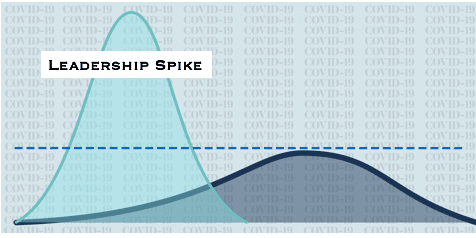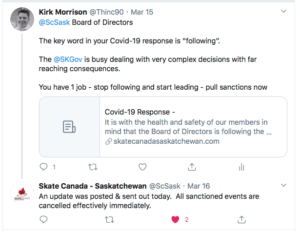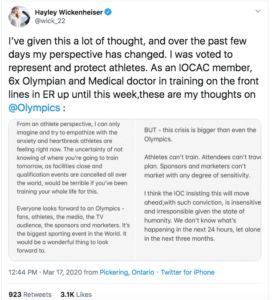
A Leadership Spike is the only way to “flatten the curve”.
In the face of COVID-19 leaders needed to take decisive action before it appeared necessary due to the incubation period associated with the threat. This required leaders to overcome fear of economic and social consequences.
In last month’s blog “The Leadership Pause” I suggested that:
- short of a national threat, the best leadership move is to pause
- anxiety gets in the way of a leaders ability to pause
- not only does a leader need to manage their own anxiety, but also the anxiety of the system
I committed to pause and do some deep thinking on the question: “What factors does a leader need to consider to manage anxiety in self and others?”
Enter COVID-19, not only a national threat but a global threat. This month I return to a case study from the world of Figure Skating and my efforts to flatten the curve with a leadership spike.
Setting the Stage
It’s March 11, only ten short days to go until “Circus on Ice” the annual carnival of the Midwest Skating club. The WHO declares COVID-19 a pandemic and the NBA shuts down. I am out of town at a conference, trying not to touch my face, and my wheels start turning about the upcoming figure skating event and how I am going to navigate the path forward as the president of the club.
It’s March 12, Hockey Canada takes the lead and issues a statement suspending the season. I breathe a sigh of relief, “This is a decision I am not going to have to make, I am sure Skate Canada will likely follow suit”. To my dismay, Skate Canada issues a statement indicating events would “continue to run as normal”.
It’s March 13, Skate Canada issues a follow up statement and again I breathe a sigh of relief. That is until I read the statement and discover that sanctioned events under 250 particpants are allowed to continue.
It’s March 14, I call a meeting of the executive for 11:00 am the next morning right after the star skate practice to discuss plans for the carnival in response to COVID-19. I consider the following factors:
1. Explore Multiple Options
When leaders get anxious they can often only see one way out of the dilemma. More calm and thoughtful leaders are able to generate multiple options for a path forward. I laid out several options available to our club from “business as usual” at one end of the sprectrum to “cancellation” at the other with a few middle of the road options.
2. Review Corporate Structure
You know that constituion that no one ever looks at… gathering dust in the basement filing cabinet…now is the time to bring it out. Clearly defined decision making processes contained within articles of incoporation, bylaws and policies lay out a structure for the process of decison making. I suggest that it says more about a leader’s character to invest effort into decision making structures and emergency preparedeness during times of low anxiety. It is too easy to sleep walk through life when times are good. Do we rise to the occasion or fall to our level of preparation? A review of our constitution positioned me to chair what was certain to be a highly anxious and emotional meeting.
3. Get Outside Perspective
I discovered that the past president has a vote through a review of our decision making structure. I called up the past president and asked him to attend the meeting. His daughter had graduated from high school the previous year and he was no longer active in the club. Without any skin in the game, I knew I could count on this individual to bring forward an unbias outsider perspective to the meeting.
4. Check Your Motives
An impromptu pairs performance between myself and one of the other dads at the wind up party last year lead to jokes about how we should perform at the carnival next year. Those jokes lead to the coach developing a routine, and suddenly, sh*t got real.
We would be skating to Brittany Spears “Circus”. Despite some anxiety over my lack of skill and out of shape dad bod I was looking forward to the show. After all, “There are only two types of people in the world, the ones that entertain and the ones that observe”. At the core of my being, I fall into the “entertain” category.
The star skaters were practising just before the big meeting was scheduled to occur. The dad’s completed a practice sesison during a break. After our first skate the can-skate coach came down to the dressing room and offered some tips to help with our jump finale:
go into the jump with speed, bent knees and arms out … explode up and rotate through shoulders while pulling arms in … land with knees bent … arms come back out solid … stick the landing
When I got back out onto the ice and landed my first jump I suddenly “got” the appeal of figure skating.
5. Define Self
Despite my desire to perform and my newly formed visceral appreciation for the sport, I was clear in my position that we needed to show leadership and cancel the carnvial. I invited everyone to speak and encouraged everyone to share their thoughts. When it became clear that a consensus decision was not possible, I defined my position and called for a vote by secret ballot.
I have witnessed leaders in the position of meeting chair who will sit on the fence and allow the group to define their position. It is important for the leader to have a clearly defined position and have the ability to state that position as objectively as possible. I have also witnessed leaders who have dogmatically maintained their position despite evidence to the contrary. Staying present to the moment is essential to a clear and objective position.
6. Leverage Social Media
When there is a leadership vacuum at the top, you can leverage social media to influence change. I leveraged our grass roots decision to do our part to flatten the curve by tweeting the Saskatchewan division of Skate Canada. This tweet may have been influential in the Saskatchewan Board of Directors’ decision to fill the leadership gap left by Skate Canada and pull sanctions a day before Skate Canada stepped up.

When senior levels of organizations and governments fail to demonstrate leadership it takes tremendous courage to go against the grain and to do what’s right. We witnessed this type of leadership with Haley Wickenheiser ‘s tweet heard around the world that may have lead to the postponement of the summer olympics.

What leadership challenges do you currently face?
What factors will you consider to manage anxiety in self and in the system?
Do you need a thinking partner?
Click here for a free, no obligation chat.





